The canvas chore coat – and buying vintage online
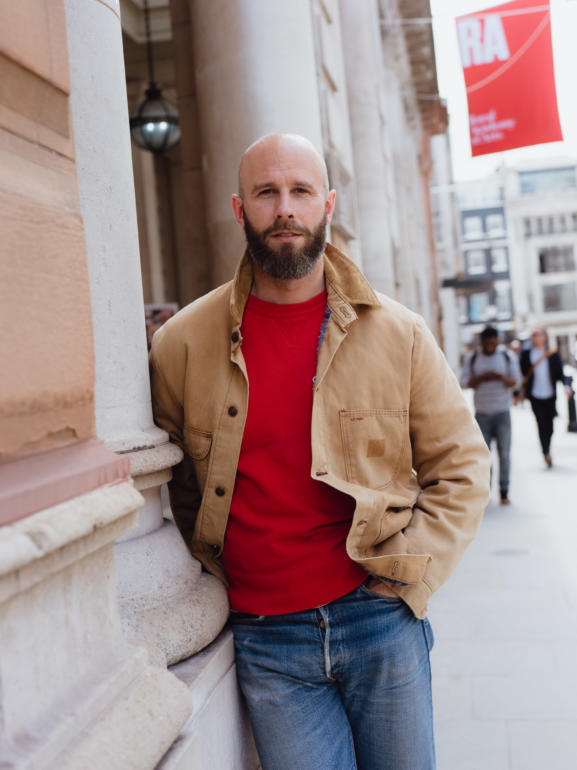
I increasingly find that for the kind of casual outerwear I wear at the weekend (for taking the kids to the park, and similarly hard-wearing activities) I always prefer vintage.
There are exceptions, of course. A Bryceland’s white chore coat, for example, bought because I love the design and know how well executed something from Ethan is.
But nigh-on everything else is vintage, largely because of the way the pieces have worn in and aged. They look so much more attractive than anything new.
The tough materials will have faded and softened. There will be little nicks and scratches, and even home repairs - which I love for the care they show someone else took with the clothing.
Now I think about it, a lot of the casual outerwear I’ve featured over the years has been like this - particularly shorter jackets. There’s my M65, my black horsehide, the jungle jacket and the old kendogi (though the latter is a bit delicate for kid-herding). Reminders of all those below.
Today’s piece is a chore coat I recently got from Broadway & Sons, which I love and is interesting to discuss because the style has become fashionable recently.
As with all fashions, I start from a position of scepticism. But I still try to stay open-minded - if you’re really interested in clothing, I think it’s worth striving to remain so.
It’s refreshing and often instructive to watch a trend evolve, to see where it goes and ponder whether, at any point, it could work with how you dress. Being closed-minded is so cold and dull.
Carhartt’s brown-duck jackets and double-knee trousers started to become trendy a couple of years ago. It made sense - they fitted with the nineties revival, the popularity of looser fits, and with both workwear and skatewear.
When I visited Le Vif in Paris earlier this year, Arthur showed Alex and I a few double-knee trousers (be aware - new/old ones are so coarse they’ll take the hair off your legs) and said Carhartt was suddenly incredibly popular.
I’ve always liked the way duck canvas ages, particularly the fading you get from sun exposure, which manages to be both subtler and more extreme than on an old bleu de travail or similar cotton.
On the one hand it’s extreme because the colour fades a lot, from mid-brown to a more recognisable straw colour. The original remains beneath things like pocket flaps, as in the image above, so you can always see how far it has come.
Yet at the same time, this creates subtle effects on the outside of the coat. This isn’t easy to see, but in the image below the shoulders of my jacket are lighter than the body, gradating slowly down onto the chest.
Also from a style point of view, the nice thing about this canvas is it’s a different colour option for casual clothing, yet remains very versatile. Similar in that respect to denim, or the green of military fatigues.
Indeed you could have both denim jeans and a denim chore, duck trousers and a chore, and green fatigues and a field jacket, and rotate combinations of them to your heart’s content. Add a white and blue T-shirt, and you have an instant capsule wardrobe.
So, I had these thoughts as I watched the trend emerge and evolve. One thing I will freely admit is that I’m a snob to the extent of not wanting to wear the same thing as everyone else - so a new Carhartt jacket was out of the question (although I understand the modern quality is still good, in the unwashed, original weight).
What I really wanted was a vintage one. It would have all the character described lovingly above, and because it could be a model that was no longer available, would solve the snob situation.
Unfortunately most of the vintage duck jackets I found were hunting varieties - a separate category really, and while more unusual than a chore, too short and wide for my style. You have to be a bigger man, like layering, and probably wear your high-waisted trousers for those to work.
Eventually, I found a likely model at Broadway. My usual approach is to check in on sites like that every month, by the way, or when I get an email announcing a new drop that looks interesting.
I keep measurements of jackets, shirts and trousers that I already own, so I can quickly see whether a new vintage piece is my size. With jackets, for example, I know that my M65 is 22.5 inches pit to pit, and that’s the minimum I need. Up to maximum of 24.
I also know I need a back length that is at least 30 inches (the field jacket is 30.5), although this is also a question of style. Those hunting jackets are styled to be shorter, and would be huge if they had that back length.
I’ve been shopping vintage for long enough now to know that my success rate is rarely more than 50%. There are just too many variables - fit, material, condition - to be consistently higher. It does vary between stores, and you can be narrower in what you buy and try, but then you also miss out on pieces that it was hard to get a sense of online.
With this Broadway order, I bought five things and returned three, keeping this chore and an old Italian airforce sweater, but returning trainers, a shirt and a red hunting jacket.
Broadway leans a bit more towards the thrift end of vintage compared to other stores. This is great for pricing, but I find also means the condition and style can be more patchy.
Also, I should make clear that this is only the second time I’ve ever bought from them - I don’t buy five pieces a month! But once you’re ordering one or two things, you might as well add in the others you’ve been looking at for a while too, just in case. The shipping doesn’t change.
To anyone that’s used to shopping from a regular shop on a high street, this could all seem a big fuss. But often it’s the only way to find good vintage. And, it has the advantage that if something’s hard to find, other people are unlikely to have it.
Plus, if you’ve been shopping for menswear for a few years, chances are there’s nothing you really need. You can easily wait and chase down that perfect piece. Indeed, it might be helpful given your consumerist tendencies to put some barriers in your way.
I don’t have much interest in buying vintage smart clothing, particularly tailoring.
The materials aren’t the same - fine suitings and shirtings are not designed to be worn heavily over long periods, and look the better for it. Heavy outerwear, such as a tweed raglan coat, is probably the only area that could be interesting.
Casual outerwear, however, always looks great. Every time I see a cotton chore jacket in a store now, I just wish it was 40 years old and had been worn every day of that time. It is a matter of - as we so often say - how great things age.
The jacket is from Big Ben, the workwear label under Wrangler that dates back to the 1920s. It was made in the US, probably in the early 70s. It is marked as a size 42, but fits me well over a sweatshirt, as here.
The jacket cost €95 from Broadway & Sons. Despite my winding journey to this one, they’re not always hard to find and often not expensive. Usually getting the size you want is the issue. Worth making that list of measurements.
The red sweatshirt is a vintage Champion, bought at Le Vif. The quality is not the same as, for example, a Real McCoy’s one and I wouldn’t necessarily buy it again, but I do like the fit and colour. The jeans are my vintage Levi’s. Out of shot are suede boots.
Photography: James Holborow


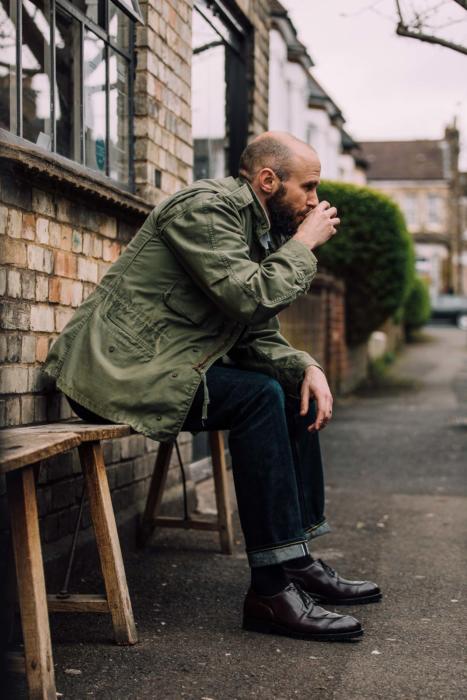
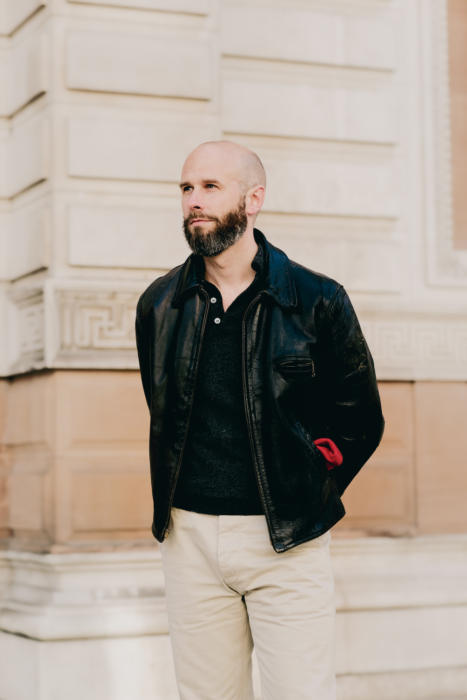
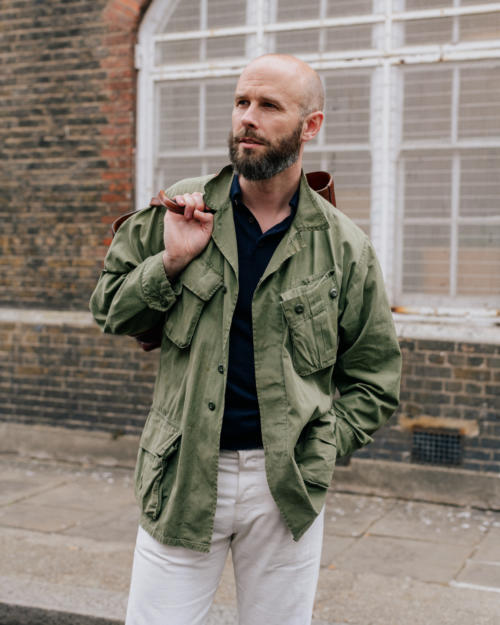
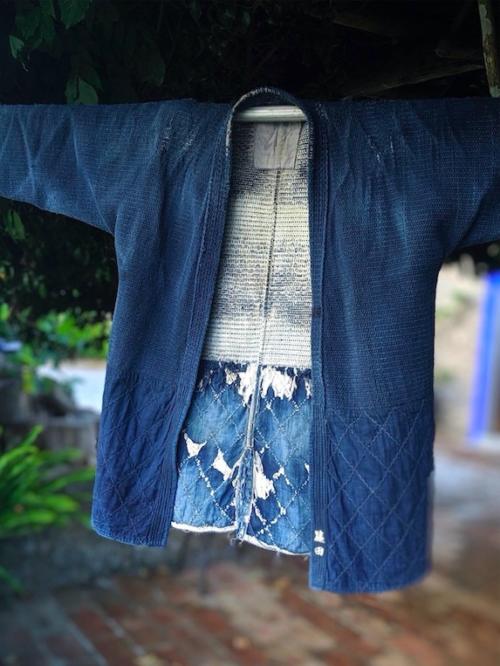
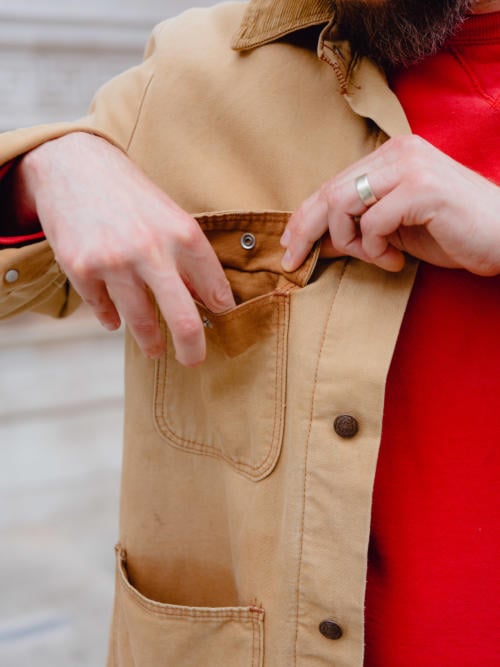
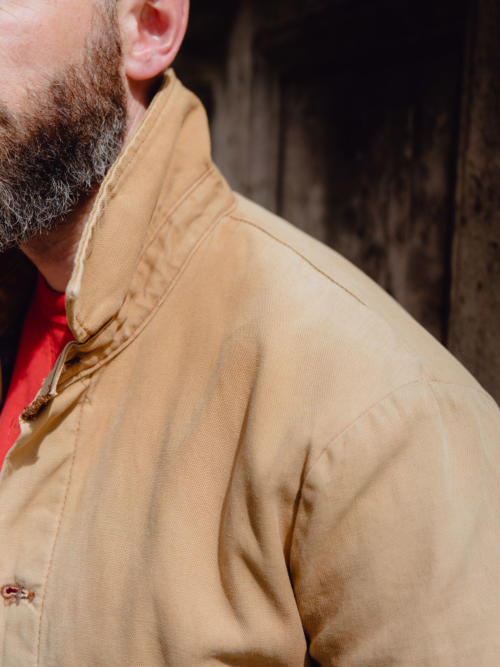
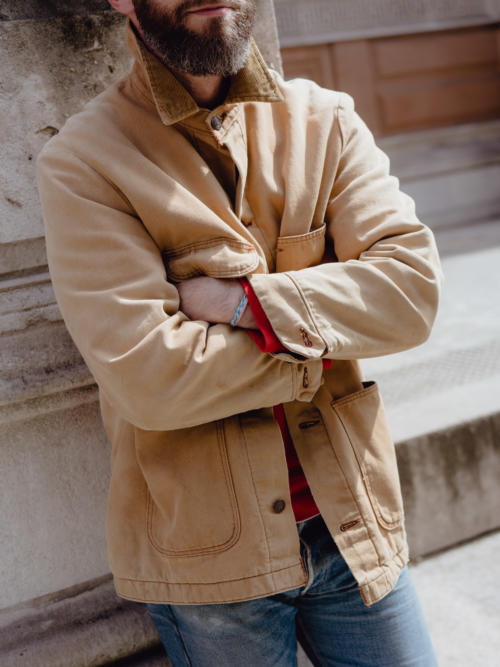
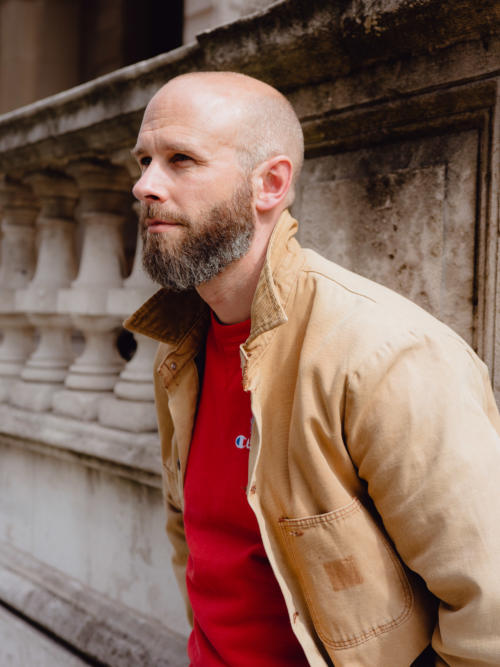
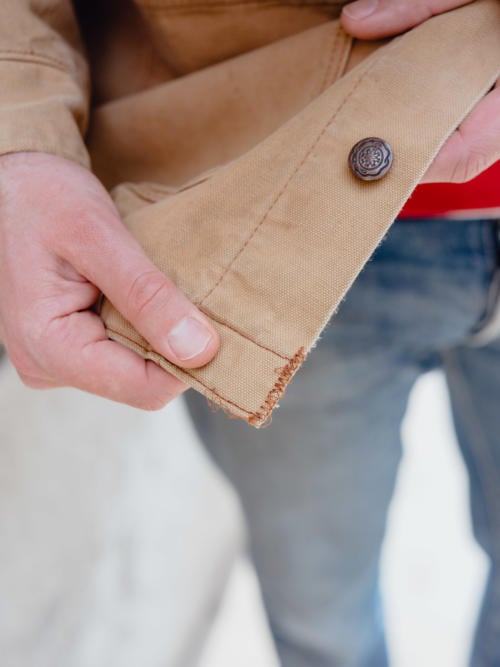
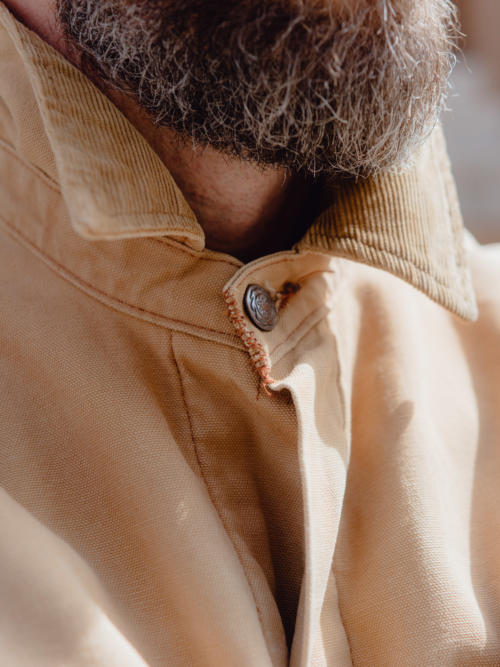
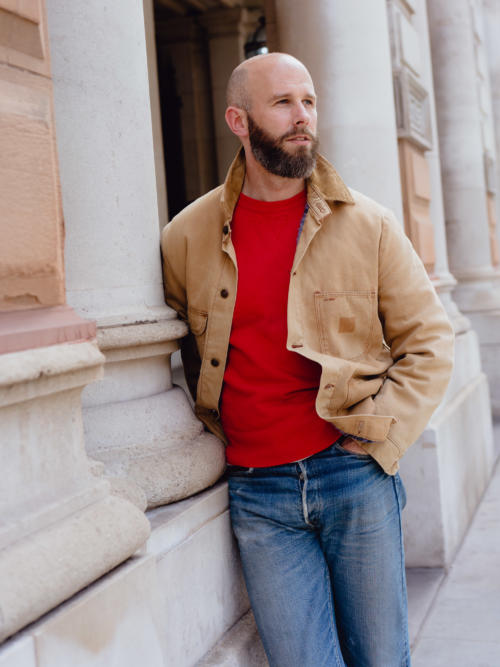


























I do love a good canvas jacket. I seem to recall Belstaff made a thick cotton jacket(in their four pocket,belted style) in a lovely light brown. Has this jacket padding in the shoulders or it is just the style?
No, no padding in the shoulders
Hi Peter. They don’t do them every season. I managed to get a field master (drawstring not belt) version a couple of years back. Good for the summer as an alternative to a safari jacket. Unfortunately they seem to do the technical materials a lot at the moment, but hopefully revisit canvas in a future season.
Hi Stephen. I’ve done a little digging and the model was the Weymouth. It’s more chore coat than waxed/motorbike jacket,but still has the four pockets, which might be a little crowded.
Compelling argument for vintage casual wear. Where might you look if you were after something in the chore coat kind of area, but wanted to be able to wear it with tailored cotton trousers, Oxford cloth shirts, and loafers? I’m in a casual working environment where tailored trouser + tailored jacket feels a bit much, but I can happily wear a tailored jacket and jeans, or a more casual jacket with tailored trousers. Just trying to find that right piece though that can dress down a slightly smarter ensemble as well as dress up jeans and boots
Not vintage but Drake’s was the first place that came to mind.
Yes of course, Drake’s does that even more than tailored jackets these days
I think a vintage workwear piece like this is probably too casual for that kind of situation, Peter. I’d suggest a more ‘luxe’ kind of chore, like the jackets A&S do, or the Anthology lazyman jackets, that kind of style. A lot of brands do some kind of version these days – we’ll do a survey of them all later in the year
I think Peter’s suggested outfit might work as high-low dressing.
Perhaps. To me it sounded more like he wanted an everyday outfit to wear, rather than something that stood out in that way
Iron Heart have a khaki corduroy ,Peter
https://www.ironheart.co.uk/jackets/ihj-69-kha.html
You could also take a look at Armoury’s City Hunter 2 and 3 Pocket Blouson, those are bit smarter options, more appropriate for office.
Thanks m. Both of those covered here
Even wearing an old faded canvas chore jacket myself today…
I find myself drawn more and more towards vintage pieces these days. The struggle is to find the right balance between curated and expensive (LeVif !) and thrift and cheap. Furthermore, the vintage online retail is very inconsistent.
Do you plan on releasing a list of the good vintage online shops based on your experience ? Your article on Brut Clothing comes to mind.
Cheers
Sure, I can see that would make a good article. In terms of where to look, I think you need to consider both the more expensive and the cheaper, but realise that if you go more expensive, you’re getting someone else doing a lot of the work for you – whereas if you go to Broadway, for example, it will take more time and trial and error to get the right piece.
Which you prefer depends a little on how much time and money you have. I tend to have more of the latter, less of the former. But I know friends who are the opposite and are quite happy to spend a long time searching online shops and eBay.
I guess I’m more like your friends, then! I also feel like it is not so much about how much time you spend rather than the uncertainty you get with vintage.
For example, I’ve tried looking for a vintage pair of 501, not necessarily vintage, but the size of the waist, the rise, the lenght is so random that it is impossible not to try a pair before buying it.
I must have tried close to 50 pairs and not one was fitting remotely OK, ranging from a 30 to 36 waist.
Outerwear is definitely easier to choose from.
Yes, outerwear is easier, and jeans particularly hard. The looser the trousers (eg fatigues) the easier to size
I unfortunately didn’t have a great experience with Broadway & Sons. Rather than shipping my order to my home address, they had it shipped to a UPS drop-off point without telling me. They claim that their T&Cs say they sometimes do that, but it certainly wasn’t communicated transparently. The package arrived at the drop off point just before I left on a business trip, and by the time I returned home and tried to collect the package it had been returned to sender. I definitely won’t be shopping with Broadway & Sons again.
As a larger man I find vintage shopping to be frustrating. I’ve desperately wanted a military coloured field/jungle jacket for years at this point, preferably vintage. But as I’m too large for military service, it stands to reason that no military jackets have ever been made in my size!
I agree with this, like you I’ve been looking for a vintage jungle jacket for some time but my size just never comes up.
As a resident of a city with few if any good vintage stores, online is often the only option and it also opens up international stores, which is great.
More generally, the importance of accurate and detailed sizing information seems to overlooked by some retailers with an online presence – whether they’re selling vintage or new. Waist and inseam often isn’t enough when buying trousers. Thigh and rise are also vital (and much less easy to alter significantly). Waist is a really useful measurement on shirts or tops, but not always included.
Some retailers provide a wealth of useful information (Casatlantic springs to mind), but others are less good. I appreciate taking more measurements takes time, but surely it’s not as costly and time-consuming as dealing with potential lost sales or the additional returns created by a lack of sizing information.
I think you’re right JH, and I think it’s important to realise that that’s one more thing you pay for from a higher-up vintage shop – measurements and service.
These things are not free or quick to do with a regular shop, and a vintage one is even harder, as you’re often doing it all for just a single item of clothing, whereas with new stock you’re doing it for dozens of identical pieces. This is what frustrates me when people ask where vintage prices (even at the cheaper end) come from
I have found that vintage sellers are pretty good at providing sizing information, even at the lower end. Service that they have is of course good, but that is mostly relevant only at the brick and mortar. What really sets the higher-end shops apart, for me, is that pretty much everything is worth buying.
I am, however, equally baffled as JH at the lack of information given by retailers that sell new clothes. Since much of the trade has gone online, it can be quite costly to not do that, as JH points out.
The fact that it’s probably bad business aside, there are at least two reasons that make that especially hard to understand. First, measuring surely isn’t too costly if you measure once for every ten or hundred pieces sold. Second, you shouldn’t even need to measure because the measurements should be available long before the item hits the stores (or even before they go into production). If they’re privately designed, the seller owns them to begin with. If not, they should get the measurements from the brand they’re representing.
On a side note, it would be very interesting to learn why some companies don’t share the measurements. I’m pretty sure someone like Ralph Lauren or Hugo Boss, with their marketing budgets, can’t hide behind the cost. Since this seems to be a problem with the bigger brands, I can’t help but to think there’s something they’d rather not share publicly.
There are some pretty boring but fussy issues to getting measurements online for new products. For my company, and one which I think is quite common, the main challenge is just a systemic one of somebody taking the measurements at the right time, and getting the data to the people that are putting the products on the website at the right time (generally a completely different team).
It’s difficult to do at scale especially – we typically launch a couple of thousand products a week, so what seems like an easy win could be multiple full-time jobs of taking and recording measurements. Agreed that it’s worth doing, but certainly can be tricky.
The above will often be done in concert with other activities, like when the products are moving through the photo studio. It’s not unusual for a product’s exact spec to change around that time, so measurements can vary from the final product.
For a small company where the overall launch volume is small (or the actual stock levels are much smaller, potentially just one-off products) it’s probably more doable – I guess at that stage it’s just the effort of collating and presenting measurements for a product that only has one unit of stock behind it. It’s all going into the overheads.
Lastly, for many brands we simply don’t have a lot of confidence in the consistency of their measurements. There are certain well-known jeans makers who are a running joke for the variance you can get in actual waist measurements between two apparently 34″ jeans, but many makers are the same. By giving that data, customers tend to expect they will be exact for the product they receive.
Hi Simon, off topic again: do you happen to have any updates on the madras cloth? Thanks a lot!
No worries. I’m afraid the mill made a mistake with the madras and we won’t be getting any this summer. Sorry – very frustrating
Got it! Yes I imagine how annoying that can be for you. I was looking forward to that!
Sorry Gabriele. We will try again
This oft heard complaint of the price of vintage, or the price of anything, is a confusing one. Price is relative, you do not pay for old or new, you pay for something you want and then it comes down to a simple question; ‘how much are you happy to pay’? If they ask too much then don’t buy it. Other than being the same as everyone and therefor happier paying less, I have always preferred a well curated shop with higher prices than a cheap shop stacked to the ceiling with anything and everything. The cheap shop may well have cheaper bargains but I value my time too much to waste it looking through too much rubbish to find a a holy grail. Each to his own of course. As for endless measurements; I have to shop remotely most of the time and time spent on accurate measuring and asking questions is rarely wasted because it avoids the pain of returns/refunds/taxes and personal angst.
I think the length is an important point that often gets overlooked. For example, yours in the pictures looks good to me for this style. On the other hand, that’s the one complaint I have on Drake’s chores: mine comes in at 70 cm for a 40, which is less than ideal, and as a results looks a bit too boxy.
Simon, check out L.C. King outerwear. A great variety of duck and denim jackets, 5 pocket jeans, and other items. I’ve found vintage on eBay.
The company started in 1913, is family owned and operated today by the founder’s great grandson. Great products made in the USA in Bristol, TN.
Wonderful, thank you Tony I will
I can vouch for L.C. King. Bought a couple work shirts which wash up nicely. A heritage brand sourcing fabric from stateside mills. Small batches. Low glam factor. Definitely workwear. Nice selection of chore jackets if you stateside guys can’t source at the local thrift shop. Price point within reach. Very few US clothing manufacturers remain so take a chance and throw them some love.
Another vote for L.C. King here – I’ve had one of their Pointer Brand shawl-collared chore jackets for nearly a decade and it still looks great.
I do not buy vintage because I AM vintage, and as I have always tried to buy the best quality I could afford over time, starting in the 80’s, I am still wearing clothes I bought decades ago…
Nice! No interest in clothes before that time then Eric?
?
Cracking article Simon, wicked jacket as well, looks great on you. Always been a fan of duck canvas and this is an amazing example.
I have a question, do you reckon an element of the appeal of vintage outerwear stems from the fact that, the older the jacket gets, the more it starts to take on ‘artefact’ status? Perhaps not the best way to phrase it, but I think you know what I mean. You’ll possibly recall, I said something similar about your vintage black horse hide, before you wrote that article and I kept seeing it in the backdrop of your videos. So mysterious, so much character.
I too have started suffering from the same dilemma recently when I see a nice jacket, particularly leather ones, immediately wishing it was 30 years old and worn everyday of those years. Do you reckon it’s worth it to just bite the bullet and buy new sometimes if the fit + quality is spot on? You know it’ll look amazing eventually, patience is the tricky bit. I love vintage, but it is a skill, my success rate being 0%.
Thanks, and sorry to hear that on vintage. Interested to hear where it’s gone wrong – I’m still trying to work out the best way to cover this area and give people good advice.
On buying new, I think it depends a lot on how many clothes you have. If you’re going to wear the jacket at least once a week, ideally two or three, then it will age pretty fast. Less than that and it becomes harder
Truth be told I just haven’t dedicated enough time to isolating specific pieces I think. It’s mostly been a case of trying something on for the fun of it when I happen to be in a vintage store (rare occasion), but the fit or something just isn’t right. I think if I said to myself “right, I’m going to buy a vintage M65 and I don’t care how long it takes to find the right one” I might get somewhere.
I’ve been doing A LOT of clearing lately and haven’t been buying much at all, so a jacket like that from new would be getting wear everyday probably, given my lifestyle (tech, work remotely), so hence I’m willing to pay up for the right one when I find it.
OK thanks, good to know on the vintage coverage, and sounds like you’re in a good place for a jacket like that which takes some good wearing in
It might be worth casting your expect eye over the online sites, Simon. For example Vinted or Thrifted. Plenty of pitfalls for the unwary, but,if you avoid the rather flexible usage of ‘Vintage’ there are certainly a few gems.
Thanks Peter. I do look at those and of course eBay too, though it tends to be when I’m looking for something very specific – an old Ralph cap for instance. Otherwise the quality and styles seem to be too large and random for my time/patience
I’ve lived for a long time in the State where Carhartt is based and am so impressed by the company’s ability to penetrate all fashion castes. I can’t think of any other brand that I see on road crews and high end apparel blogs on the same day. And I can’t imagine another brand featured on here most of whose employees could care less about clothing.
Is there a classic unlined chore coat from carhartt?
Carhartt WIP do. The Manchester store certainly had them last year.
Simon, what size did you take in the Bryceland’s white chore coat? How do you find the sizing? Have you experienced any shrinkage (if you’ve washed it)? Thanks!
I took a 40, which worked well, but I’ve never washed it. Bit concerned about doing so now – might dry clean it instead to avoid any possible shrinkage
Hi Simon, I couldn’t agree with you more on the appeal of vintage outerwear for the weekend. The most strenuous thing I do over the weekend now is playing with my young son in the park and walking my dog in the woods. I have a vintage Barbour Northumbria for the winter and an old M65 for the rest of the year that in my opinion work and look far better for these activities than all the colourful synthetic sports outwear people wear these days. And they will probably last longer as well.
Great article simon and i love when you do a casual article that common people can wear often and look good in it. I also mentionen that the last year i wear more and more vintage pieces. For example this week i found in a greek vintage store a pair of cream jeans trousers that look ectremely good with tailoring too and costed 35 euro. For chore coats i think the most i have seen where in amsterdam but many of them at this difficult light blue. I d like to ask something, im looking for a long time to find a zip up casual boot. I know you are not a fan of those but have you seen anything nice around ?
No, sorry, as you say not something I’d normally look for.
Why a zip though? Why not a Chelsea boot? A lot more elegant than a zip
I tried once in Barcelona at a used shoe store a zipped boot and it looked way better that i thought but was not my size.. since then i havent found anything that i liked.. which brands would you suggest for chelsea boots ? Id like something for casual wear
All of the traditional makers do a Chelsea boot really, English or French or Italian. Among the English I’d look at Crockett & Jones or Edward Green for different price/quality points
Carmina makes a decent looking side zip boot: https://www.carminashoemaker.com/zip-boots-brown-suede-80688
Aw thanx ill try them for sure, that really helped
The jacket looks very nice Simon. What is duck canvas? Is it a heavy cotton?
Yes, a heavy coarse cotton designed for work
I have a Ralph Lauren that is somewhere between a chore and a hunting jacket, bought on a holiday 30 yrs ago in the Hamptons after their ‘season’ had finished after Labor Day, so it was dirt cheap (and $2 to the £). I didn’t know it was called duck canvas so thank you for that! It has no branding other than a tag label inside and has faded superbly just as you have described, from a dark buff in pockets to a pale cream on the shoulders. It could well outlast me, and it’s a favourite that I know my sons have had their eyes on over the years but they’ll have to wait.
Hi Simon,
I have been buying men’s clothes for 60 years, so I have several pieces that are considered vintage: a Maine Guide shirt from LL Bean that I bought in 1957 when Bean’s was for working men – the shirt is thick wool, now faded but makes a great layer under a Filson tin cloth jacket from the 70’s. I have several leather jackets that are 40 or 50 years old – they have been relined and professionally patched. I have several items from Willis & Geiger – heavy denim shirts on which I have had the collars turned. I have had the sleeves turned on several smarter coats as well. These are all old items that have grown old with me. I find there becomes a line between vintage and “threadbare.” Vintage means there is still some residual value, threadbare means the item is just old. You are correct, tailored clothing seldom becomes “vintage” except for tweed jackets which can still be worn even if they lose their shape. I find your quest for vintage interesting, yet one that seems to short circuit the aging process of fine, well-made clothing. So I have a question: do you ever buy a casual or everyday jacket or other item of clothing new, that you know will last decades, in and out of style, with the intent of keeping it regardless – that your love of the workmanship, of the material, of the brand transcends your obsession with looking unique or different.
Jack Williams
Hi Jack,
Sounds like you have some lovely pieces.
Absolutely, I certainly do that. I’ve always focused on clothes that last in that way, and how different they look to others isn’t never a big consideration. My Chapal leather jacket, covered recently in the How Great Things Age series, is probably a good example. Also my Cabourn parka in the same series. Have you seen either of those?
In the US we have Army Surplus stores which are a great source of both new and old and new casual wear. I don’t know if you have anything similar in the UK.
A bit off-topic, but for a couple of decades I’ve worn beautiful and distinctive vintage watches, both solid gold and stainless steel. I’ve probably never paid more than $2,500 for any of them, and generally spend a lot less. I highly recommend the practice. The owner of Second Time Around in Beverly Hills where I’ve bought many of them and who I go to for service and repair work, tells me that most of his sales are now online.
We haven’t had that type of store for a long time Thom, no, but the military vintage remains in second-hand stores. A good amount of it is American too, just because the volume was so large, and there were later conflicts in Asia the US was involved with.
The watches sound lovely – I’ve covered mine before, and they were all pre-worn, though only one (a 68 GMT really counts as vintage.
Hi Simon, I am looking for a sweatshirt with a slighty shorter fit, any advices? Should I go vintage ? Broadway and sons has quite e few on their website… Or is there any brand that you recomend?
Many of the Japanese makes have a shorter cut in their sweatshirts – eg Real McCoys, and their ballpark sweat in particular. Those also shrink about an inch after washing, making them shorter still.
RRL also has a shorter cut sometimes, which is worth looking out for.
Thank you!
Hi Simon,
I find this article to be particularly helpful for me, as I have never really gotten into vintage. Yes, I enjoy when my pieces are tattered and worn, but only when I have an emotional attachment to the wear/tear. I much prefer to look at a rip or a repair and remember that I got it from playing with my kids or something like that. Getting something vintage removes the fun out of getting something new and beating it up and watching it age over time. Like buying an orange that’s already been squeezed.
While it’s clear you thoroughly enjoy your vintage pieces, do you find you prefer your more “authentically” (for lack of a better term) worn pieces?
-Richard
I certainly have more emotional attachment to those Richard, and I can definitely see where you’re coming from.
I still like the other vintage though – it represents a variation of use and styles, and in some cases use that I simply would never be able to give something, like a horsehide jacket that has been beaten into softness over years. You have to wear something almost every other day for many years for that kind of wear
Hi Simon,
I seem to have a little bit of a polar opposite view to the vintage look.
I do enjoy the worn-in look, but I feel like I have to wear it in myself to not feel like a fraud of sorts, and for that peculiar snobbery I never can really be that enthusiastic as many now seem to be regarding vintage shopping.
And then there’s the second problem regarding the issue on the look; As me also having a bit of an excessive wardrobe, it’s quite unlikely to actually wear anything in to the extent of them having a worn appearance. Or when it get worn down it’s most likely just inferior quality andfor that reason I still can not be satisfied.
This is also why I’m not allowed inside the denimhead circles, as I am unable to produce “the sick fades” that seem to be required to fully appreciate denim and the subculture behind it (Except maybe Pure Blue Japans, which even I seem to have capability to wear enough).
Duck, funnily enough, seem to fade quite quickly and get those wrinkles and greases just after a wash or two, which is enjoyable. Unfortunately heavier ducks usually chafe, so I either have to man up or get them half-lined.
So I’m not sure if I had any point in this rant, but this particular subject had me venting a bit.
PS: Boxier fits do not always suit the bigger man, as a broad-shouldered and barrel-chested they make me look either A) Refrigerator’s cardboard box or B) Dick Tracy villain.
PSPS: It’s a bitch being this much of a snob!
What are your thoughts and opinions on the classic French chore coat? I believe they are made out of moleskin if my research is correct? I’ve had my eye on one for a couple weeks now, and am not sure if I should go for it. What do you think? I’m probably not a huge fan of the classic blue they typically come in, but I’m thinking of perhaps a navy version. What do you think?
I think that style is pretty universal now among brands, and useful with more casual clothes. Don’t worry about having it too traditional though – the heavy cotton they more usually come in is great, but so are other materials. And I’d encourage you to try that blue, rather than navy – it’s not the same colour palette as tailoring
Why do you like the typical blue they come in? Is it authenticity? Is it that the colour itself is particularly versatile? Is it just for something a bit different than the usual colours found in most men’s wardrobes? Any other reasons?
I find it unusual yet also easy to wear and versatile. It’s clearly casual (more so than navy) and has it’s own character. It also fades slowly over time, often showing how it has been worn
What is your opinion on buying a new Carhartt/Carhartt WIP chore jacket? How is the quality in your opinion? What are your thoughts on those specific brands? WIP seems to be targeting a more premium audience, but is it in fact premium or just branding and hype? Are there other options when looking for a duck canvas chore jacket?
I’m afraid I haven’t looked seriously at the new ones, and haven’t tried them. Sorry.
I think the quality of Carhartt has declined as they have added more man made material tor coats.
My preference would be to look for vintage .
However, my son is very happy with his blanket lined Dickies chore,it is 100% cotton,but is half the price of Carhartt so I’m doubtful of any real quality..
i feel like so many RTW moleskin and drill chores are offered in some shade of khaki. Does this color eliminate wearing khaki chinos with it?
If they’re a similar shade, then yes probably. Could look a little odd otherwise
You mention that a capsule wardrobe could very well consist of pair of denim jeans and denim jacket, a pair of duck trousers and duck chore jacket and a pair of green fatigue pants and field jacket – paired with a white and blue t-shirt to round out the base layers. Obviously, I think this might be a very particular wardrobe on it’s own, but it got me thinking more about adding this “layer” to my wardrobe in addition to some of the other posts you’ve made about the casual capsule wardrobe. Specifically, regarding adding duck canvas to the mix. You said that “the nice thing about this canvas is it’s a different colour option for casual clothing, yet remains very versatile. Similar in that respect to denim, or the green of military fatigues”.
Carhartt double-knee trousers have become extremely popular as of late, which you mention. What is your opinion on the double-knee work pants from Carhartt as an addition to your wardrobe? It’s obviously not going to be as versatile as a pair of dark jeans or beige chinos, but do you think they would operate in the same way a pair of green fatigue pants do, albeit in a different colour and material – lending to more potential outfits variations. Do you think they would be a welcome addition, or would you tend to steer clear of them and only look to the canvas chore jacket?
I think they’re great, but they would be more specific, a little harder to wear than a canvas chore. The double knee thing also has to be something you love and don’t mind explaining to people now and again!
I’ve heard of canvas before, but never thought to incorporate it into my wardrobe. I’m now considering it.
As you said, it’s a colour that works well with other casual menswear colours – the indigo of denim and olive/army green. I’m assuming this also extends out to the other clothing items you’ve mentioned over the years. I don’t want to list them all here, but I’m referring to many of the other casual wardrobe posts you’ve written.
It also seems to have many of the good qualities that make raw denim so great – very durable, softens and fades over time, and improves with age. Both these factors offer a compelling case to consider canvas.
The colour and fabric are now out of the way, and on to the styling – the double-knee. I agree that a chore in the same colour and material is an easier addition to a casual wardrobe. The double-knee pants are more of a “look” compared to a standard beige or khaki chino. However, do you think they would still be considered a “classic” or “timeless” item? Many classic menswear items are derived from military wear, work wear, or sports wear. Similar to the others, the double-knee pants seem to have been around for a very long time.
They’re definitely not plain and likely a bit unusual for the masses, but I would maybe liken them to fatigue pants, which you’ve recommended a few times before. The small details add up to make it a bit more interesting and fun to mix into certain outfits. Is there a reason why you like the fatigue pant and not the double-knee pant? Do you think they’re in the same category?
I think they’re more unusual than the fatigues, but I know what you mean. I do think there’s a chance double knees could prove to be a bit more of a fashion thing. So if you’re concerned about that I’d probably avoid them
If you’re able to, could you maybe elaborate a bit more on what makes a double-knee more unusual compared to a fatigue? Is it just because there are more “details” built into the design?
Yes I think so, largely. Not just the knees but the various pockets and the hammer loop, they all stand out more. Combat pants with their thigh pockets would do so too, and monkey pants (arse pocket) even more
I didn’t know about combat pants or monkey pants, but I took a look and I can see what you mean. There seems to be a lot going on.
Similarly, the double-knees do have a few extra pockets and the hammer loop. Do you think they would go out as far as the combat/monkey pants in terms of being overly detailed or stylized in a particular way/aesthetic or do you think they would be a bit more traditional in design and still fall within a standard menswear repertoire?
Do you think that they would work well as an option in addition to some of the other casual pants, tops and jackets you’ve talked about in other casual capsule wardrobe type posts before?
I’d say they’re kind of on a par with the combat pants – not really a traditional, standard menswear piece.
They could certainly work alongside other pieces in the wardrobe like that, but they’d be an interesting exception, something to play with and be a touch more showy.
Hi simon if you had to choose between a jungle jacket and one of them hbt jackets (those olive militaey shackets with twin chest pockets) which would you say is more useful if you had to pick one?
I like the jungle jacket personally, but that might be because the twin-chest pocket ones tend to be rather short on me
Dear Simon,
I hope this comment finds you well. I am new to your extremely impressive website and this type of fashion more generally. So naturally, I am but a captain on a small wooden boat on what feels like 40 foot waves. Being in this position, I tend to resort to seeing what the opinions of people with more feel and experience in menswear have and listen to them.
I have recently purchased a Tomas Coat from the Swedish brand Oscar Jacobson. However, I am slightly iffy about it. I love the fabric as it adds texture to the outfit and makes a wee bit of a statement. However, I am not sure if it is the ideal purchase to make. This is because I want to have a coat that is versatile in the sense that you can dress it up with jeans, with a pair of trousers and a lambswool sweater or have it more formally over tailored clothing (I am thinking here of the Medium Gray Donegal Herringbone – Balmacaan by Spier & Mackay). My current options of coats are the Berg & Berg Nelson Coat and the Permanent Style Donegal Overcoat which you collaborated on. Both the latter and former are within my budget but I realise I need something that is ‘easy’ to wear (in the sense it is easy to match it with other garments without too much difficulty) and I was hoping you could guide me in the right direction.
I have attached a few photo so you have a sense of how the jacket looks with clothes that I have. If you think I should keep the jacket, would you also be so kind to make suggestion on how to make it work? I have until Friday to return it so fingers crossed if you are able to reply before then.
I also want to thank you in advance for your help and your advice. It is very much appreciated! (sorry accidentally posted comment before without attaching the photo lol)
With best wishes,
Matin
Hi Matin,
Thanks for the message, and always happy to help.
May I ask what colours the Nelson Coat and our Donegal Overcoat are in? I would have thought the donegal would have been a more versatile option in grey, if that’s what you were looking for.
S
Dear Simon,
Many thanks for your response! I was between the grey donegal coat and the navy Nelson raglan coat. As you say, the idea for me is something “easy” and not difficult to match with trousers, jeans, knits or shirts a like. I apologize for the lack of clarity on my part!
Best,
Matin
Ah I see, so those are ones you were considering as well? To be honest, I would say the grey donegal would be a better choice, it’s the only coat I’ve ever had which bridges everything from jeans to black tie. Obviously I’m a little biased, but mostly to the degree that it just reflects my preferences. The light grey is coming back in all sizes this autumn
Dear Simon,
Thank you for patience and your responses! I think I’ll keep my eye out for light grey donegal’s autumn drop. I’m looking forward to be able to wear it across the spectrum of my fashion taste and not do it too much of an injustice haha!
With best withes
Matin
OK, sounds good Matin. You can always add yourself to the waiting list on the page for the size you want as well
For what it’s worth, I have the light grey donegal and it could easily be my only coat (if I wasn’t a bit obsessive about clothes…) It goes with jeans, boots and chunky knits. It goes with full suits. It goes with just about everything in between. I also find that it’s great for traveling, as it has no shoulder padding to worry about when you are asked to fold it up and put it in a too-small overhead bin on a plane, and the donegal means that smaller stains doesn’t really show up much compared to a solid color coat.
I had mine in at the tailors for an alteration, and I was told that once it was hanging to be picked up, several customers had asked about it, wanting one of their own. So it’s clearly a style that works for a lot of people, at least the kind of people who go to bespoke tailors.
Lovely to hear Sam!
Hi Simon, I like vintage USN peacoats, particularly those from the late ’60s and early ’70s. They are classic, well-made, and I have been fortunate to find them in my size. They are made of dark navy Kersey wool with black buttons. I wear them casually with dark denim jeans and black service boots. I would like to wear a peacoat with mid-blue, or even faded, denim. However, I am hesitating because I am not sure what color footwear, besides black, would be appropriate for a coat that has black buttons and don’t feel black goes well with faded denim. Any suggestions?
I think that would be fine with dark-brown footwear or even other colours David. It’s not that smart a combination with that Kersey wool or the jeans, so I wouldn’t worry about matching the tones too closely. Apart from dark brown I’d look to burgundy/Color 8 cordovan, and then even snuff suedes
Thank you, Simon.